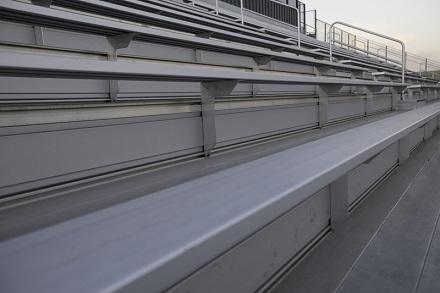

Here are a few stories worth noting:
• The home-side bleachers at Greenwich (Conn.) High School’s Cardinal Stadium were closed last spring after an inspection revealed they were not built to code 50 years ago when they were installed. Local officials discovered that building codes dating back to the time the permits were issued on the bleachers required them to bear 100 pounds per square foot, according to the Greenwich Time. The original bleacher permits, however, did not make any mention of load-bearing measurements. The bleachers, as they stand now, do not meet code.
The town’s Board of Estimate and Taxation approved an allocation of $120,000 to allow the school district to pursue design work and obtain more information about the costs of replacing the bleachers and using the space underneath them for a variety of improvements (including team rooms and enhanced restroom access), the paper reports. A vote is expected in September.
Meanwhile, according to the Greenwich Time, chairs were set up on the field for family and friends during high school graduation, and temporary bleachers will be installed for fall sports.
• Joe Etheredge Stadium at Choctawhatchee High School in Fort Walton, Fla., was closed earlier this summer after school officials said the harsh Gulf Coast climate had taken a toll on the 52-year-old facility and made it unsafe. “A mandatory state inspection by structural engineers revealed shifting, misalignment and gaps in the concrete seating that could cause them to collapse,” reports the Northwest Florida Daily News.
According to Okaloosa School Facilities Director Bill Smith, repairs are underway and include using hydraulics to lift the rows of seating and move them a few inches back into their original positions. The total cost should not exceed $200,000, Smith added.
“Further damage exists in seating at the 50-yard line that extends up to the press box,” the paper adds. “The concrete there exhibited cracking and chipping. To fix the cracked and chipped concrete, engineers must smooth it out and strengthen it with a structural repair mortar. That will ensure no loose pieces fall to the ground.”
Officials hope the improvements will be completed before the Choctawhatchee High School football team’s home opener on Sept. 6.
• Rusty bleachers at Waterloo High School Stadium in Atwater, Ohio, have forced administrators to reschedule all home football games this fall. Waterloo Athletic Director and Head Football Coach Mike Divies told FOX8 in Cleveland that he hopes a levy on the local November ballot passes, which likely would provide funding to build new stands.
In the meantime, administrators at Marlington High School in nearby Alliance, Ohio, invited Warterloo’s football team to use their stadium for four “home” games this season
Bad bleachers also are a problem for some small colleges. Crews in Hickory, N.C., were expected to demolish the concrete home-side grandstands at Moretz Football Stadium on the Lenoir Rhyne University campus this summer. According to WBTV, a CBS affiliate in Charlotte, N.C., the 54-year-old structures had been showing cracks in recent years.
Plans call for the use of temporary bleachers during the 2019 season, with the expectation that permanent grandstands will be added in time for the 2020 season.
Event owners who are using stadium facilities should check with local sports commissions and venue operators to ascertain bleachers are safe for spectators.

